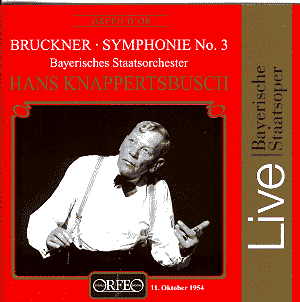Both the timing (at least five minutes short of most performances)
and the mealy-mouthed half-explanation of the performing version used
here may give an indication that this is Bruckner’s Third, but not as
we know it. The symphony has the most complex history of versions and
editions of any I know: a full account is given in the Bruckner discography,
though the excellent Stephen Johnson writes a more readable version (is
that version 1a, or 2? Bruckner 3 gets to you like that after a while)
in his notes for Hyperion’s recording of the 1877 version (with 1876 Adagio)
conducted by Osmo Vänskä. That disc is worth acquiring not just
for the notes but for a thrilling and intelligent performance of almost
the most cogent version of the symphony. This disc? It is, I suppose,
worth hearing because you wouldn’t otherwise believe how desperate some
companies are to make money by peddling bad nights in the concert hall
by good musicians as ‘of historical importance’.
However well-meaning Franz Schalk was when he slashed
Bruckner’s longest symphony (in its original version) to ribbons to
make it more palatable for a contemporary audience, the results are
not just a betrayal of Bruckner’s harmonic language but more fundamentally
of his gift to make large paragraphs of different sorts of music knit
together. I hope that Schalk’s few recordings, including some exciting
Beethoven, will one day rescue him from bogeyman of Brucknerian history
status. In the meanwhile the exhumation of this performance does him
no favours. Intonation, rhythmic accuracy and ensemble are so wretched,
so often, that niceties of balance and tone colour come to seem like
desirable but dispensable extras.
Knappertsbusch sets in motion the mysterious, descending
arpeggios that anchor the whole at a sensible tempo, at which the haunting
trumpet theme falls and rises in one noble swoop. For some minutes the
odd slip can be ignored, the occasional filled out chord or phrase.
But after a while it begins to tell: the essential starkness of the
music is completely lost under a welter of unintentional mistakes and
determined Wagnerisms on Schalk’s part. The music winds down to a complete
standstill between 15’ and 16’, Schalk having cut the necessary linking
passage.
At least the performance of the first movement held
some kind of shape while the edition robs it of sense. Schalk does less
to the Adagio (cutting two parts entirely of its ababa construction)
but the players do a thoroughly successful hatchet job. Even the glowing,
vernal second theme of the adagio sags under the strings’ inability
or unwillingness to give the phrase shape. The introduction of the third
theme is dogged by poor ensemble and intonation. Strings veer between
ploddy and desperately out of tune, the recording recesses most wind
parts and when it doesn’t they are often sharp. Off-cuts from the Munich
Bierkeller Band (Reserves) break in at unpredictable moments: the brass
intervention at 9’50" is so crude that after a few seconds the
engineers decide to tame it. The Scherzo fares least badly; Kna’s feeling
for this music, a dance by turns gentle and boisterous but always good-natured,
was innate, and the strings offer a rough simplicity which suits it.
Worse is to come in the finale – a whole chapter in
a recent volume of Bruckner studies is devoted to why the post-1877
versions of this movement make little sense compared to the two up to
that point. You don’t need to read it, however, to hear that after Bruckner’s
initial conglomeration of polka and funeral chorale the music starts
to unravel in a disconcerting fashion at 5’50" and limps from there
to what feels like an undeservedly grand conclusion. Knappertsbusch’s
lumbering tempo doesn’t help to unify the material: we are a world away
from the satisfaction engendered by Vänskä or by Haitink’s
two recordings.
Anyone who loves Bruckner’s music or Knappertsbusch’s
conducting should steer clear of this travesty.
Peter Quantrill


